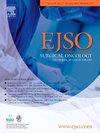Developing a deep learning-based surgical-skill assessment model focused on instrument handling in laparoscopic colorectal surgery
IF 3.5
2区 医学
Q2 ONCOLOGY
引用次数: 0
Abstract
Introduction
Poor instrument handling, such as "repeatedly makes tentative or awkward moves" and "grasper (frequently) slip," is associated with poor surgical skills. We constructed and applied an automated recognition model of tissue grasping during laparoscopic surgery using computer vision technology to clarify whether automated surgical-skill assessment using the number of tissue grasps could be feasible.
Methods
The number of tissue grasps and classification of success/failure were manually and automatically counted. Intraoperative videos of three groups with obviously different surgical levels (the high-, intermediate-, and low-skill groups) were prepared; an automated distinction between these groups was attempted using the models.
Results
The number of manually counted tissue grasps was significantly higher in the low-skill group than in the other groups, while the number of failed tissue grasps was significantly lower in the high-skill group than in the other groups. The number of automatically counted tissue grasps showed strong correlations with the manually counted ones, whereas the other parameters showed only moderate correlations. The number of automatically counted tissue grasps was significantly higher in the low-skill group than in the other groups, similar to that noted with manual counting. The other automatic parameters showed no results similar to the manual ones.
Conclusion
We successfully constructed automated recognition models of tissue grasping during laparoscopic surgery and found that automated surgical-skill assessment based on the number of tissue grasps could be feasible. However, the results were insufficient for automatically distinguishing between successful/failed tissue grasps. Further improvements in recognition accuracy are required for this model.
开发一种基于深度学习的手术技能评估模型,专注于腹腔镜结肠直肠手术中器械处理
不良的器械操作,如“反复做出试探性或笨拙的动作”和“握持器(经常)滑动”,与较差的手术技巧有关。我们使用计算机视觉技术构建并应用了腹腔镜手术中组织抓取的自动识别模型,以阐明使用组织抓取次数进行自动手术技能评估是否可行。方法人工统计和自动统计抓组织次数及成功/失败分类。制作高、中、低三组手术水平差异明显的术中视频;尝试使用模型自动区分这些组。结果低技能组人工计数组织抓握次数显著高于其他组,高技能组人工计数组织抓握失败次数显著低于其他组。自动计数的组织抓握次数与人工计数的组织抓握次数有很强的相关性,而其他参数仅显示适度的相关性。在低技能组中,自动计数组织抓握的次数明显高于其他组,这与人工计数的结果相似。其他自动参数没有显示与手动参数相似的结果。结论成功构建了腹腔镜手术中组织抓取的自动识别模型,发现基于组织抓取次数的手术技能自动评估是可行的。然而,结果不足以自动区分成功/失败的组织抓取。该模型的识别精度有待进一步提高。
本文章由计算机程序翻译,如有差异,请以英文原文为准。
求助全文
约1分钟内获得全文
求助全文
来源期刊

Ejso
医学-外科
CiteScore
6.40
自引率
2.60%
发文量
1148
审稿时长
41 days
期刊介绍:
JSO - European Journal of Surgical Oncology ("the Journal of Cancer Surgery") is the Official Journal of the European Society of Surgical Oncology and BASO ~ the Association for Cancer Surgery.
The EJSO aims to advance surgical oncology research and practice through the publication of original research articles, review articles, editorials, debates and correspondence.
 求助内容:
求助内容: 应助结果提醒方式:
应助结果提醒方式:


